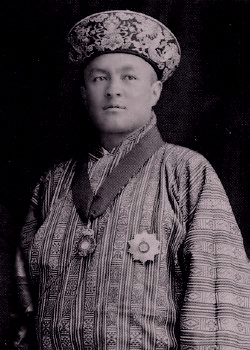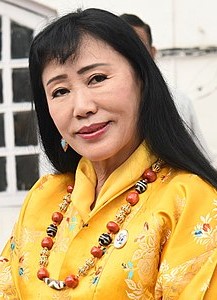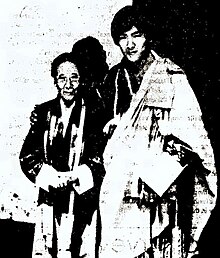
"Druk Tsenden" is the national anthem of Bhutan. Adopted in 1953, the lyrics were written by Dolop Droep Namgay and possibly translated into English by Dasho Gyaldun Thinley. The accompanying music was composed by Aku Tongmi.

The national flag of Bhutan is one of the national symbols of Bhutan. The flag features a Chinese dragon from Bhutanese mythology. This alludes to the Dzongkha name of Bhutan – Druk Yul – as well as the Drukpa Lineage of Tibetan Buddhism, which is the dominant religion of Bhutan.

Jigme Wangchuck was the 2nd Druk Gyalpo or king of Bhutan from 26 August 1926, until his death. He pursued legal and infrastructural reform during his reign. Bhutan continued to maintain almost complete isolation from the outside world during this period; its only foreign relations were with the British Raj in India. He was succeeded by his son, Jigme Dorji Wangchuck.

Zhabdrung was a title used when referring to or addressing great lamas in Tibet, particularly those who held a hereditary lineage. In Bhutan the title almost always refers to Ngawang Namgyal (1594–1651), the founder of the Bhutanese state, or one of his successive reincarnations.
DashoLhendup Dorji was a member of the Dorji family of Bhutan. He was also the brother of the Queen of Bhutan, Ashi Kesang choden and uncle to the fourth king of Bhutan, King Jigme Singye Wangchuck. He served as acting Lyonchen following the assassination of his brother, Lyonchen Jigme Palden Dorji, on April 5, 1964.

Prince DashoJigyel Ugyen Wangchuck is a Bhutanese prince. Born as the second son of the King of Bhutan Jigme Singye Wangchuck, he was the heir presumptive to the throne of Bhutan until 5 February 2016, when his nephew Jigme Namgyel Wangchuck, his older half-brother and current King Jigme Khesar Namgyel Wangchuck's son, was born.

Princess AshiSonam Dechen Wangchuck is a princess of Bhutan. She is the daughter of the fourth King of Bhutan Jigme Singye Wangchuck and his wife, Queen Mother Ashi Dorji Wangmo Wangchuck. She is half-sister of the fifth King, Jigme Khesar Namgyel Wangchuck.

Queen Mother Dorji Wangmo is the Queen Mother of Bhutan, and first wife of former King Jigme Singye Wangchuck, who is married to four sisters all of whom were entitled to be called queen.
Dasho Jigme Palden Dorji was a Bhutanese politician and member of the Dorji family. By marriage, he was also a member of the House of Wangchuck.

Simtokha Dzong also known as Sangak Zabdhon Phodrang is a small dzong. It was built in 1629 by Zhabdrung Ngawang Namgyal, who unified Bhutan. It is the first of its kind built in Bhutan. An important historical monument and former Buddhist monastery, today it houses one of the premier Dzongkha language learning institutes. It recently underwent renovation.
The national symbols of Bhutan include the national flag, national emblem, national anthem, and the mythical druk thunder featured in all three. Other distinctive symbols of Bhutan and its dominant Ngalop culture include Dzongkha, the national language; the Bhutanese monarchy; and the driglam namzha, a seventeenth-century code on dress, etiquette, and dzong architecture. Natural symbols of Bhutan are its national flower, the Himalayan blue poppy; its national tree, the Himalayan cypress; its national bird, the raven; and its national animal, the takin.
The Dorji family of Bhutan has been a prominent and powerful political family in the kingdom since the 12th century AD. The family has produced monarchs, Prime Minister of Bhutan, Prime Ministers, Dzong lords and governors. The fourth king of Bhutan Druk Gyalpo, Jigme Singye Wangchuck, as well as his son the current fifth king of Bhutan Jigme Khesar Namgyel Wangchuck, are also members of the Dorji family and therefore also descendants of the royal family of Sikkim. The Dorji family is also the holder of the Bhutan House estate in Kalimpong, India.
Bhutan House is an estate located in Kalimpong, West Bengal, India, owned by the Dorji family of Bhutan. The site is the traditional administrative Dzong for southern Bhutan, and also functioned as the administrative center for the whole of western Bhutan during the modern kingdom's early years of consolidation. It represented the relationship between Bhutan and British India, and is a modern symbol of Bhutan–India relations.
Sir Raja Sonam Topgay Dorji CIE, also called Tobgay, was a member of the Dorji family and Bhutanese politician who served between 1917 and 1952 in the Royal Government under the First and Second Kings of Bhutan. During this period, Topgay Dorji officially held the posts of Gongzim, Deb Zimpon, and Trade Agent to the Government of Bhutan. As such, Topgay Dorji was responsible for fostering Anglo-Bhutanese relations, and later, Bhutan–India relations. Topgay's ties with the west and modernist political factions contributed significantly to the modern political landscape and modernization of Bhutan.

Ugyen Dorji was a member of the elite Dorji family and an influential Bhutanese politician. He served as the closest adviser to Ugyen Wangchuck, the Penlop of Trongsa and later King of Bhutan. Ugyen Dorji was instrumental in fostering friendly relations with the British after the Bhutan War (1864–1865), and providing support to the British expedition to Tibet in 1904. Operating from Bhutan House in Kalimpong, India, Ugyen Dorji used his position to open Bhutan to the outside world, establish Bhutan's foreign relations, and operate a lucrative trading outlet.
Dasho is a Bhutanese honorific that is bestowed upon individuals, along with a red scarf kabney, by the Druk Gyalpo. In common practice, however, many senior government officials and social elites are incorrectly addressed as Dasho without officially receiving the title and the red scarf kabney.

Ashi Kesang Choden is the Queen Grandmother of Bhutan and the widow of the late Jigme Dorji Wangchuck. She participates in royal duties of her own accord. She is the only queen grandmother in the world. In Bhutan she is called The Royal Grandmother.
Ashi Tashi Chodzom Dorji is a much-loved figure in Bhutan, having played a significant role in modern history, international relations and cultural life.
Princess AshiDechen Yangzom Wangchuck is the daughter of the fourth King of Bhutan Jigme Singye Wangchuck and his wife, Queen Mother Ashi Tshering Yangdon Wangchuck. She is the sister of the fifth King, Jigme Khesar Namgyel Wangchuck.

Ashi Tsundue Pema Lhamo (1886–1922) was the first Queen consort of Bhutan.











